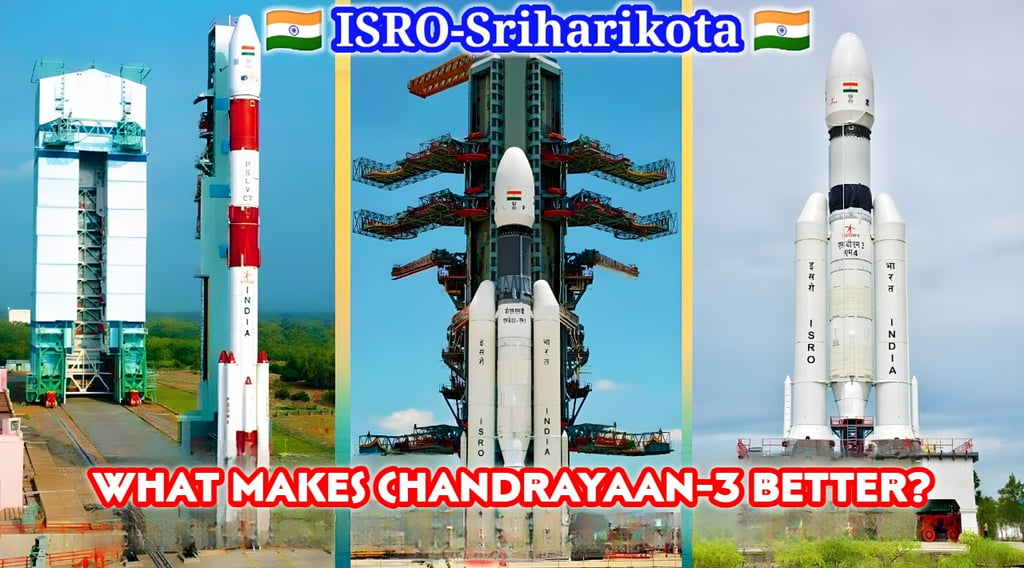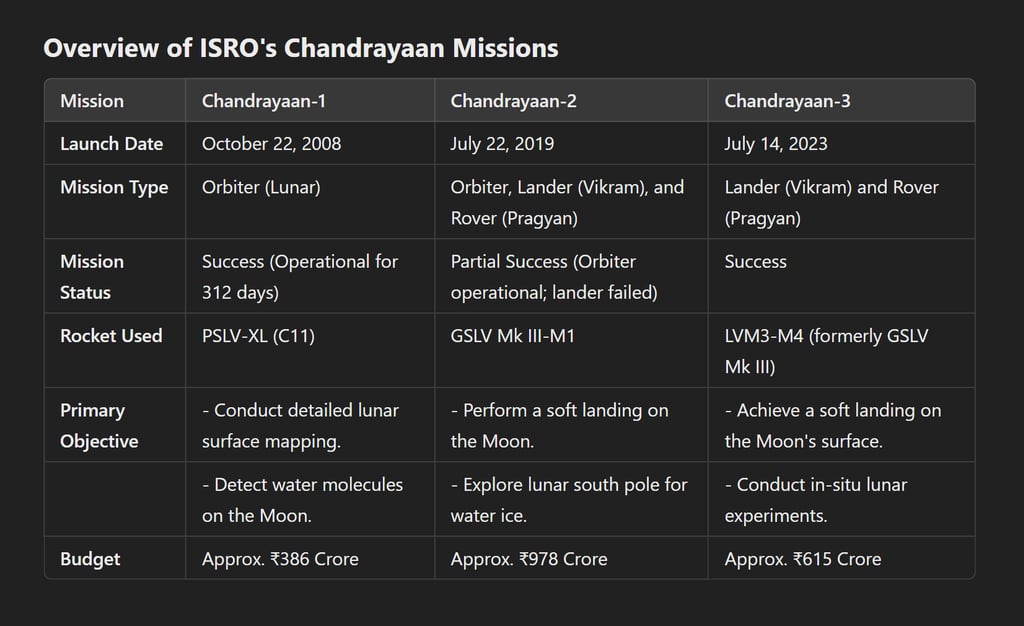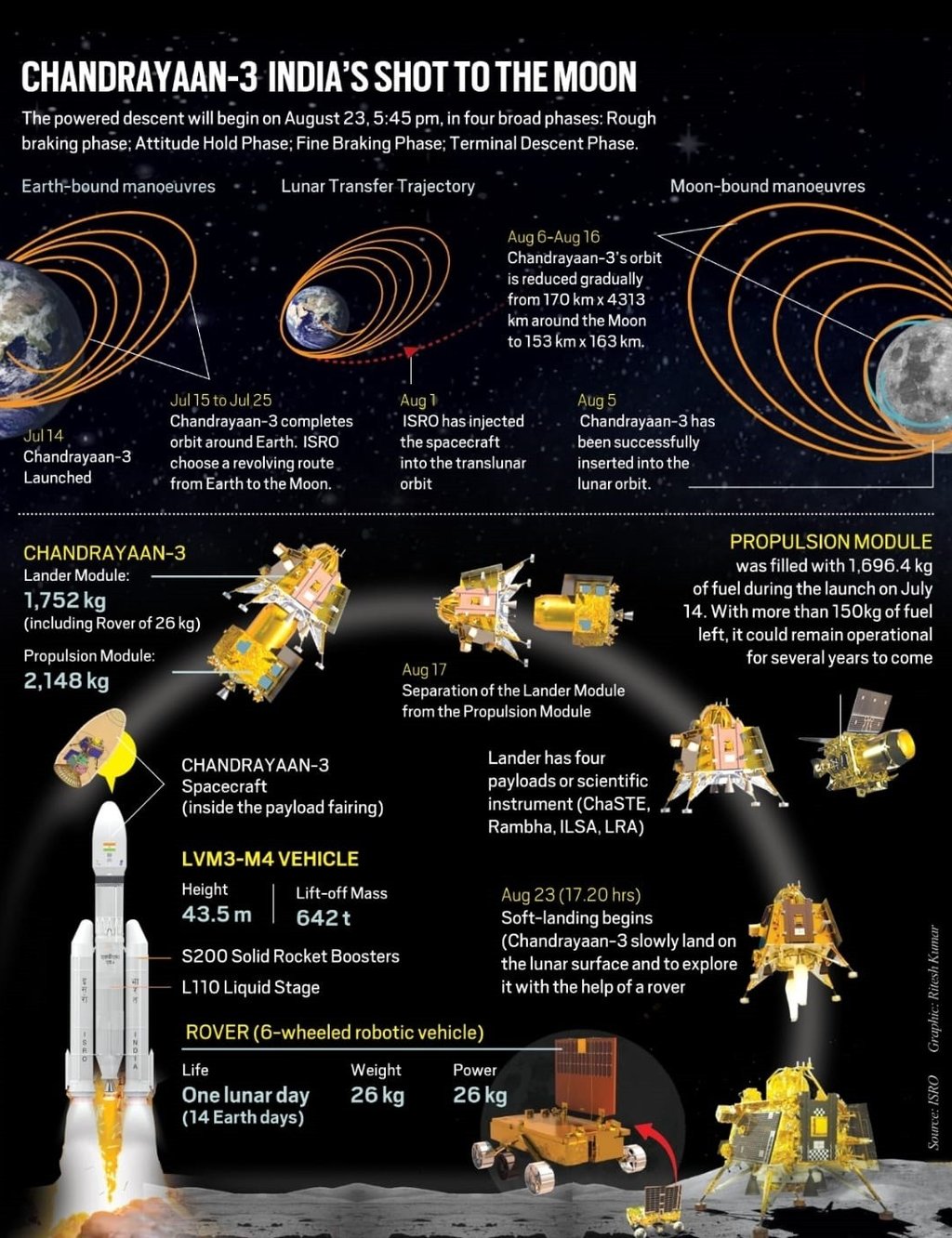
Why does ISRO need Chandrayaan-3 mission?
Exploring the Moon's south pole is a pivotal goal for space agencies worldwide due to its scientific significance, resource potential, and strategic advantages. Learn why this uncharted lunar region holds the key to future space exploration and sustainable human presence in space.
SPACE/TECHMODERN INDIAEDUCATION/KNOWLEDGEISRO/NASASPACE MISSION
Keshav Jha
12/14/20248 min read


If you search on Google, you will get this.
The primary objective of the Chandrayaan-3 mission was to demonstrate a soft landing near the lunar south polar region and perform experiments using the instruments on Vikram and Pragyaan. The spacecraft was launched on July 14, 2023, onboard an LVM3-M4 vehicle from SDSC, SHAR.
I Think It's Boring😒😒
Let's Have Our Point of View!
The Indian Space Research Organisation (ISRO) has become synonymous with innovation and resilience in space exploration. With Chandrayaan-3, ISRO aims to take another giant leap in lunar science and technological achievement. This mission is not just a continuation of India's lunar exploration ambitions but a critical milestone in advancing humanity’s understanding of the Moon.
Let’s dive deeper into why Chandrayaan-3 is significant and how its satellite design underpins this vital mission.

Building on Chandrayaan-2’s
Chandrayaan-2, launched in 2019, aimed to study the Moon's south pole and deploy a rover to conduct scientific experiments. While the orbiter succeeded and continues to operate, the Vikram lander faced a hard landing, preventing it from achieving its surface goals. The partial success of Chandrayaan-2 left much to be desired but also provided valuable lessons.
Chandrayaan-3 is a refined and more focused mission. Unlike its predecessor, Chandrayaan-3 will not carry an orbiter; instead, it will consist of a lander and rover, leveraging the Chandrayaan-2 orbiter for communication and observational support. This focused design allows ISRO to concentrate resources on achieving a soft landing and conducting detailed surface studies.
Chandrayaan-3 Satellite Configuration
The Chandrayaan-3 spacecraft is composed of the following key components:
Lander Module (LM)
The lander module is designed to perform a soft landing on the moon's surface, particularly in the rugged and shadowed south pole region. Key features of the lander include
Advanced Autonomous Systems: Equipped with sensors, cameras, and software to detect hazards and ensure a safe landing.
Payloads for Scientific Research: Includes instruments to measure seismic activity (lunar seismometer), thermal properties, and plasma environment near the surface.
Navigation and Guidance: Powered by advanced algorithms to ensure precision landing, even in challenging lunar terrain.
Rover Module (Pragyan)
Once the lander successfully touches down, it will deploy the Pragyan rover to explore the lunar surface.
Mobility Features: A six-wheeled design enables the rover to traverse the Moon’s surface and study its terrain.
Scientific Objectives: Equipped with spectrometers and cameras to analyze the mineralogical composition of the lunar soil. It will also search for water ice, a critical resource for future space missions.
Propulsion Module
The propulsion module is responsible for transporting the lander module into lunar orbit. While its primary function is transportation, it also carries a small scientific payload to study the Earth-Moon system.
Scientific Goals of Chandrayaan-3
The Chandrayaan-3 mission is tailored to achieve specific scientific and technological objectives, including:
Unlocking Lunar Secrets
Water Ice Research: Exploring the Moon’s South Pole, Where Permanently Shadowed Craters May Host Frozen Water. This discovery is vital for understanding the Moon’s evolution and for supporting future human colonies.
Surface Composition: Analyzing the chemical and mineralogical makeup of the lunar surface, which can provide insights into the moon’s history and the solar system’s formation.
Testing Advanced Space Technologies
Chandrayaan-3 provides ISRO with a platform to test state-of-the-art technologies, such as
Autonomous navigation and hazard detection.
High-precision thrusters for controlled descent.
Robust systems to endure extreme lunar temperatures and vacuum conditions.
Contributing to Global Lunar Science
The Moon’s south pole holds immense scientific value for its unique geology and potential resources. By sharing Chandrayaan-3's findings, India will contribute to international research efforts and future lunar missions.
Why Does ISRO Need Chandrayaan-3?
To Prove Technological Resilience
The Chandrayaan-2 mission demonstrated ISRO's technological capabilities but also highlighted areas for improvement, particularly in soft landing mechanisms. Chandrayaan-3 is an opportunity to prove that ISRO has learned from its setbacks and is ready to tackle complex space challenges.
Strengthening India’s Space Leadership
A successful Chandrayaan-3 mission would place India among a select group of nations, including the U.S., Russia, and China, that have achieved soft landings on the Moon. This milestone would solidify India’s position as a global leader in cost-effective space exploration.
Expanding Lunar Science
Lunar exploration is no longer just about national pride; it is about contributing to humanity’s collective understanding of the Moon. Chandrayaan-3 will provide critical data to scientists worldwide, fostering international collaboration.
Economic and Technological Spin-Offs
Developing cutting-edge technologies for Chandrayaan-3 can stimulate advancements in other sectors, including telecommunications, robotics, and defense. These spin-offs can drive economic growth and technological innovation within India.




Key Highlights of Each Mission?
Chandrayaan-1 (2008)
Objective: India's first lunar mission aimed to study the Moon’s surface and chemical composition.
Key Discovery: Confirmed the presence of water molecules on the Moon, a groundbreaking finding that changed our understanding of lunar geology.
Outcome: Despite losing contact prematurely (after 312 days instead of two years), Chandrayaan-1 achieved its major scientific objectives.
Chandrayaan-2 (2019)
Objective: Aimed for a soft landing on the Moon's south pole, exploring water ice and conducting in-situ experiments.
Achievements
The orbiter remains operational and continues to send valuable data about the Moon’s atmosphere, terrain, and minerals.
The Vikram lander failed during its descent, crashing due to software and technical issues.
Chandrayaan-3 (2023)
Objective: Focused on achieving a successful soft landing and surface exploration with upgraded technologies.
Achievements
Successfully landed on the Moon's south pole on August 23, 2023, making India the first country to do so.
Rover Pragyan has been conducting surface experiments, including studying soil composition and detecting minerals.

Why is Chandrayaan-3 Special?
Improved Technology
Upgraded navigation, propulsion, and landing systems based on lessons learned from Chandrayaan-2.
Focus on Success
Unlike Chandrayaan-2, Chandrayaan-3 does not carry an orbiter, allowing ISRO to channel its resources into landing and surface operations.
Historic Achievement
First successful soft landing on the Moon’s south pole, a region of immense scientific and resource potential.


Why Do Space Agencies Want to Explore the Moon's South Pole?
The Moon has always fascinated humanity, serving as both a scientific mystery and a beacon of potential for future space exploration. While lunar missions have primarily focused on the Moon’s equator and northern hemisphere, the Moon's south pole is emerging as a focal point for space agencies around the world. Why this particular region? Let's explore the scientific, strategic, and technological reasons behind the growing interest in the Moon’s south pole.
Presence of Water Ice!
One of the most significant discoveries of recent lunar missions, including India’s Chandrayaan-1, is the detection of water molecules on the Moon. The south pole is particularly promising because it contains areas that are permanently shadowed and never exposed to sunlight. These areas, such as the craters at the Moon’s south pole, are thought to harbor significant quantities of water ice.
Why is water ice important?
Support for Human Life: Water is essential for life support in future lunar habitats. Water can be split into hydrogen and oxygen, which could provide astronauts with drinking water, oxygen for breathing, and even fuel for rockets.
In-Situ Resource Utilization (ISRU): Water ice at the Moon's south pole can be converted into drinking water or oxygen for space missions, reducing the need to transport resources from Earth. This is key to sustaining long-term human exploration of the Moon and beyond.
Unique Scientific Research Opportunities!
The lunar south pole presents some of the most scientifically intriguing opportunities. Its permanently shadowed craters, along with the region's untouched landscape, offer valuable insights into both the Moon’s geological history and the broader history of our solar system.
Preserved Ancient Materials: The craters are cold traps, meaning they have likely preserved ancient lunar materials that could date back billions of years. These materials are untouched by solar wind or micrometeorite bombardment, offering a glimpse into the early history of the Moon and the solar system.
Astrobiological Potential: The South Pole’s stable, cold environment may offer an ideal location to study the preservation of organic compounds, which could be relevant for understanding the origins of life on Earth or the potential for life elsewhere in the universe.
Ideal Location for Future Lunar Bases
As space agencies set their sights on sustained human presence on the Moon, the south pole is emerging as a preferred location for establishing lunar bases.
Constant Sunlight for Energy: While parts of the South Pole are in permanent shadow, other areas receive near-constant sunlight. This makes the region ideal for solar energy generation, providing a reliable power source for lunar missions.
Stable Temperature: The South Pole's relatively stable temperatures compared to other regions on the Moon make it more hospitable for long-term exploration. These stable conditions could make it easier to build habitats and store equipment safely.
Strategic Location for Deep Space Exploration?
The Moon's south pole could play a pivotal role in deep space exploration as well, particularly in the context of missions to Mars and beyond.
Launch Platform for Space Missions: With its low gravity and abundant resources (like water ice), the Moon could serve as a staging ground for missions deeper into space. By using the Moon as a refueling and launch point, space agencies could reduce the cost and complexity of missions to Mars and asteroids.
Gateway to the Solar System: Establishing a base at the south pole could allow for easier access to the rest of the solar system. Lunar resources, including fuel derived from water ice, could significantly reduce the need for Earth-based supplies, making long-term space missions more feasible.


International Collaboration & Global Leadership?
Exploring the Moon's south pole is not only a scientific or technological pursuit but also a geopolitical one. As nations like the U.S., China, and India intensify their lunar ambitions, the south pole is becoming a site for international collaboration.
Lunar Mining and Resource Rights: The discovery of water ice and other potential resources at the south pole raises questions about resource rights. Countries with an interest in lunar exploration will likely seek international agreements on the usage of these resources.
Collaborative Efforts: International partnerships could accelerate the pace of lunar exploration. The Artemis program, for example, involves cooperation between NASA, the European Space Agency (ESA), and other countries to land astronauts at the Moon’s south pole.
Exploration of Lunar Geology
The Moon’s south pole is home to some of the most varied and intriguing geological features on the Moon’s surface.
Lunar Craters: Many of the craters in the south pole region are believed to be rich in minerals and elements that could offer clues about the Moon’s past volcanic activity and its interactions with the solar wind.
Seismic Studies: Exploring the geological structure of the south pole would provide data on the internal composition of the moon, helping scientists better understand its formation and evolution.

Chandrayaan-3 is much more than a mission to land on the Moon; it embodies India’s resilience, technological prowess, and unyielding spirit to explore the unknown. As space agencies worldwide, including ISRO, NASA, and Roscosmos, prioritize the exploration of the Moon’s south pole for its immense scientific, strategic, and resource-based potential, Chandrayaan-3 stands at the forefront of this global endeavor.
The south pole, with its vast water ice deposits and promise of sustainable lunar bases, offers opportunities to redefine humanity's role in space exploration—serving as a testing ground for new technologies, a launchpad for interplanetary missions, and a source of critical resources. Chandrayaan-3, through its focus on scientific discovery, innovation, and global collaboration, not only aims to make history but also to lay the foundation for future celestial explorations.
As the world watches India’s lunar odyssey, this mission promises to leave a legacy of courage, determination, and progress, resonating far beyond the stars and paving the way for humankind’s next frontier in the cosmos.
Subscribe To Our Newsletter
All © Copyright reserved by Accessible-Learning Hub
| Terms & Conditions
Knowledge is power. Learn with Us. 📚


